Simmered in a sweet and savory dashi-based broth, Inari age (“ee-NAH-ri ah-geh“) are seasoned deep-fried tofu pockets used to make Inari sushi and kitsune udon. You can follow my delicious and easy recipe to make homemade Inari age with just 5 ingredients.
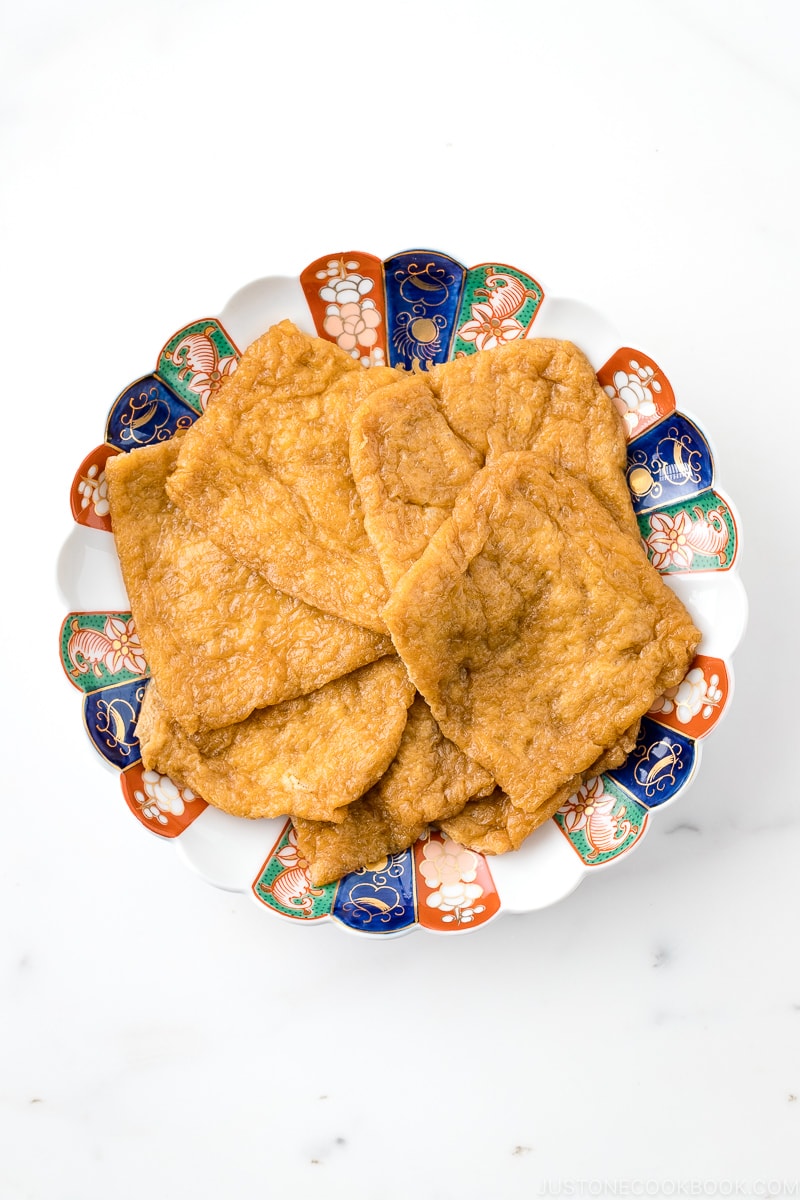
What’s Inari Age
Inari Age (稲荷揚げ, いなりあげ), pronounced as [Ee-NAH-ri ah-geh], are deep-fried tofu pockets (or sometimes called “pouches”) called aburaage that are cooked in dashi based broth, sugar, mirin, and soy sauce.
Savory, sweet, and full of juicy mouthfeel, Inari Age is the key ingredient to make Inari Sushi and as a topping for Kitsune Udon.
I often find the store-bought Inari Age too sweet to my liking, so I like making my own. It is very simple and only takes 15 minutes!
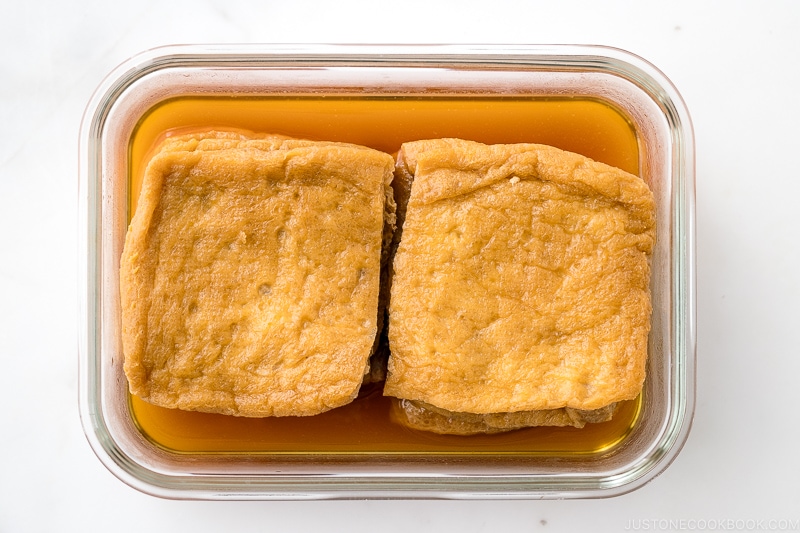
How to Make Inari Age at Home
Ingredients You’ll Need:
- Aburaage (fried tofu pouch/pocket) – A popular ingredient in Japanese cooking, aburaage are deep-fried tofu pouches made from soybean. This is a great pantry item to stock up on in your freezer, especially if you enjoy vegetarian/vegan Japanese dishes. You can learn more about how they are made here.
- Dashi (Japanese soup stock) – There are a few methods to make the Japanese soup stock. For this recipe, I used Awase Dashi made with katsuobushi (dried bonito flakes) and kombu (dried kelp). However, if you are vegetarian/vegan, you can make Kombu Dashi. Dashi is very easy to make, but you can also use a convenient dashi packet (I don’t use dashi powder).
- Soy Sauce – The most basic but compulsory flavoring that gives the broth its salty and savory taste.
- Sugar – You’ll need sugar to balance the salty flavor from soy sauce, but feel free to adjust the amount.
- Mirin – It adds mild sweetness and umami.
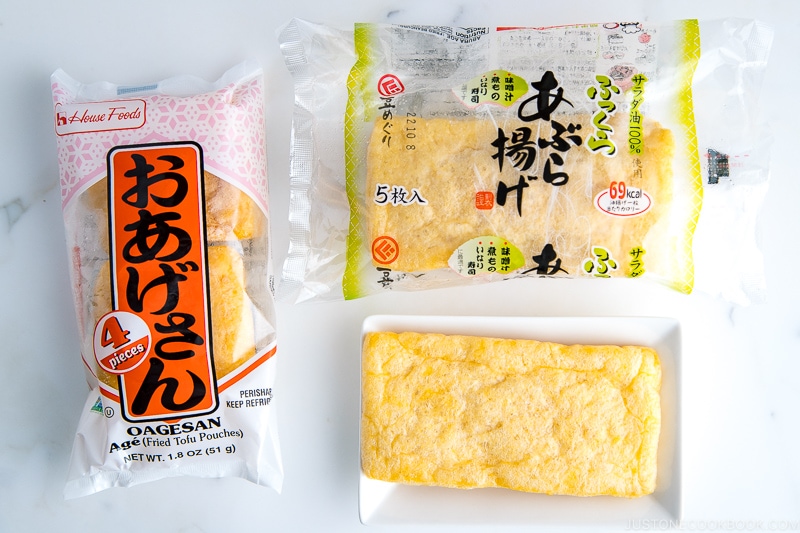
Overview: Cooking Process
- Blanch the aburaage in a boilin gwater to remove the (factory) oil for a cleaner taste. Drain well.
- Combine the ingredients for the sauce for aburaage.
- Cook the aburaage in the sauce until the sauce is almost gone.
- Set aside and let cool. The aburaage will continue to absorb more flavors.
- If you’re not using the inari age right away, you can keep them in an airtight container and store in the fridge/freezer.
How to Store Inari Age
I like to make a big batch and freeze them for later use! You can store it in the refrigerator for up to 3 days and the freezer for up to 3 weeks.

An Important Cooking Tool for Making Inari Age
Because the aburaage (tofu pouch) is lightweight and floats on the liquid, you will need a drop lid called Otoshibuta (落し蓋) when you simmer them in the pot.
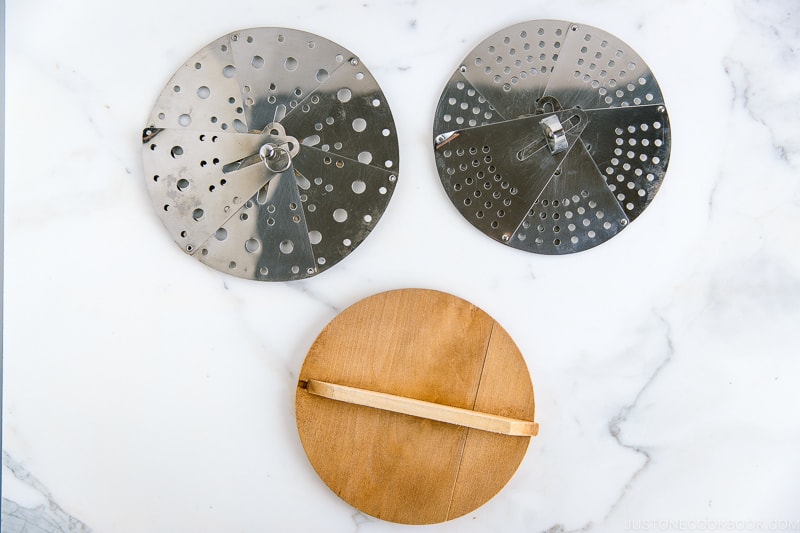
The otoshibuta is a tool that we commonly use when making simmered dishes as it helps to distribute the simmering broth evenly and prevent evaporation. If you don’t have an otoshibuta, you can make it with a sheet of aluminum foil (see this post).
I use an adjustable stainless steel otoshibuta, which can change the size of the drop lid based on different pot sizes.
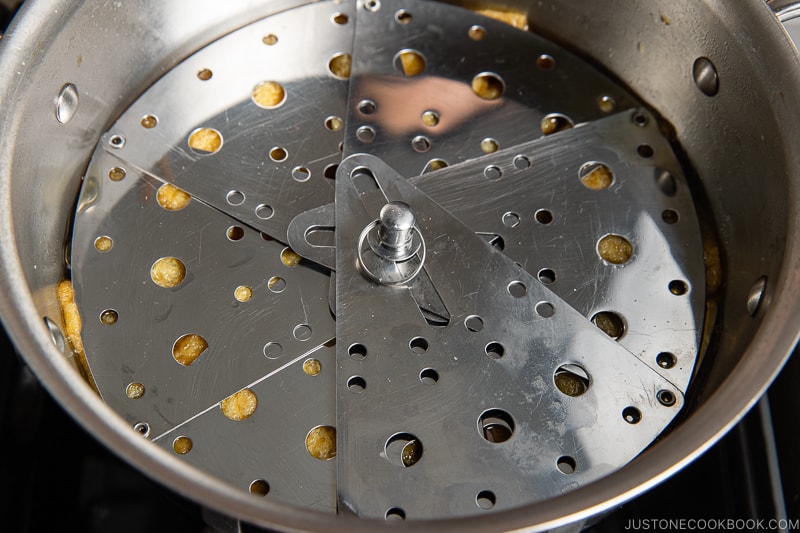
As the tofu pouches are cooked gently in the savory dashi-based broth, they absorb the amazing umami flavor and capture some of the juices for the best enjoyment.
Homemade vs. Store-Bought Inari Age
As I mentioned earlier, I often find the store-bought Inari Age too sweet to my liking. Therefore, if you can find the aburaage in your Japanese grocery store, I highly recommend making your own Inari Age.
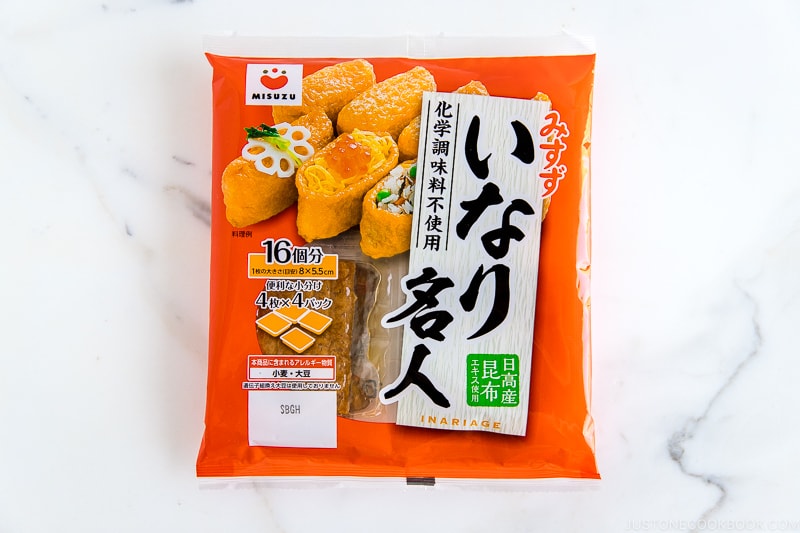
However, I’ve heard it’s very difficult to find aburaage as the majority of Asian grocery stores don’t carry it. In that case, you may find the store-bought Inari Age very convenient when you want to make Inari Sushi and Kitsune Udon.
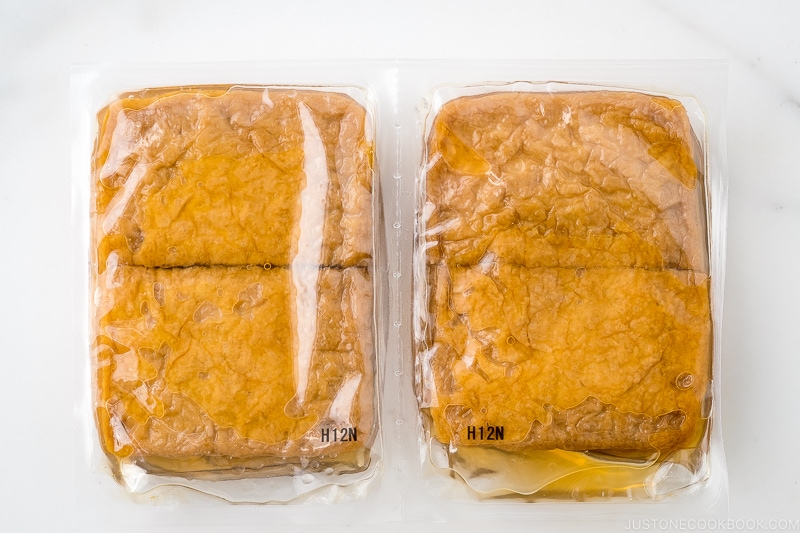
Typically you can find it in the refrigerator or freezer section at Japanese or Korean grocery stores. You may find a canned Inari Sushi which is also available on Amazon.
Delicious Recipes Using Inari Age
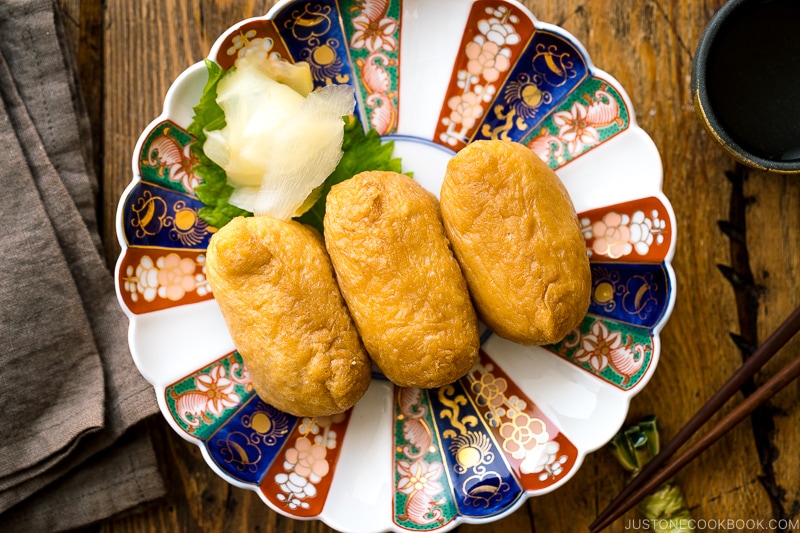
Stuff your homemade Inari Age with vinegared rice and make Inari Sushi! The sushi rice contrasts beautifully with the well-seasoned tofu pouches and you can never get enough of each bite!

Top your udon noodle soup with Inari Age for the classic Kitsune Udon!

Wish to learn more about Japanese cooking? Sign up for our free newsletter to receive cooking tips & recipe updates! And stay in touch with me on Facebook, Pinterest, YouTube, and Instagram.

Homemade Inari Age
Ingredients
- 6 pieces aburaage (deep-fried tofu pouch)
- 1½ cups dashi (Japanese soup stock) (use standard Awase Dashi, dashi packet or powder, or Vegan Dashi)
- 3 Tbsp soy sauce
- 3 Tbsp mirin
- 3 Tbsp sugar
Instructions
- Before You Start: I want you to consider doubling the ingredients, especially if you‘re making Inari Sushi. Why? The aburaage is very fragile and you may end up breaking the pouches and making holes. It‘s always nice to have backup pouches! Now, gather all the ingredients.

To Prepare the Aburaage
- Bring a medium saucepan of water to a boil. Meanwhile, cut 6 pieces aburaage (deep-fried tofu pouch) in half crosswise. Gently open the aburaage pouches all the way to the bottom. It‘s easier to separate the skin at this step than trying to open it after simmering.

- If a pouch is hard to open, gently roll it with a chopstick. This rubbing helps to separate the two sides and make it easier to open the pouch.

- When the water is boiling, cook the aburaage for 2 minutes while pressing them down into the water and turning them over. This helps to remove the factory oil used for deep-frying.

- Drain the aburaage into a sieve and rinse the saucepan. Gently press the aburaage with a ladle to squeeze out the water. Do not press hard as the aburaage tears easily.

To Cook the Inari Age
- In the same saucepan, combine 1½ cups dashi (Japanese soup stock), 3 Tbsp soy sauce, 3 Tbsp mirin, and 3 Tbsp sugar. Bring it to a boil.

- Once boiling, add the aburaage to the saucepan. Layer them in a flower petal-like shape around the pan. This makes it easier to flip the aburaage later.

- Place an otoshibuta (drop lid) directly on the surface of the aburaage (you can make your own drop lid with aluminum foil). Cook on medium-low heat for 30–40 minutes. Flip the aburaage occasionally to make sure they‘re simmering evenly. If the cooking liquid reduces rapidly, your heat is probably too high, so turn down the heat to low.

- When there is ¼–½ inch (1 cm) of cooking liquid left in the saucepan, remove it from the heat. Let the aburaage soak in the cooking liquid until it cools completely.

To Serve
- Your homemade Inari age is now ready to use in recipes like Inari Sushi and Kitsune Udon.
To Store
- Transfer the Inari age and cooking liquid to an airtight container. Store it in the refrigerator for 3 days and in the freezer for 3 weeks.

Nutrition
Editor’s Note: This post was originally published on March 6, 2013. The post has been updated with new images and a revised recipe in December 2021.
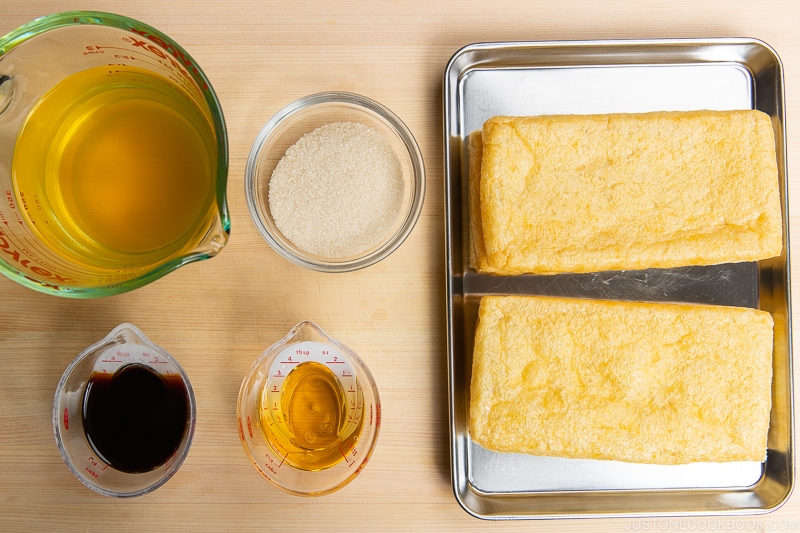
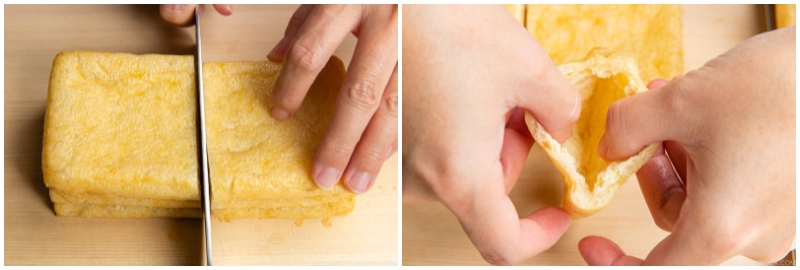
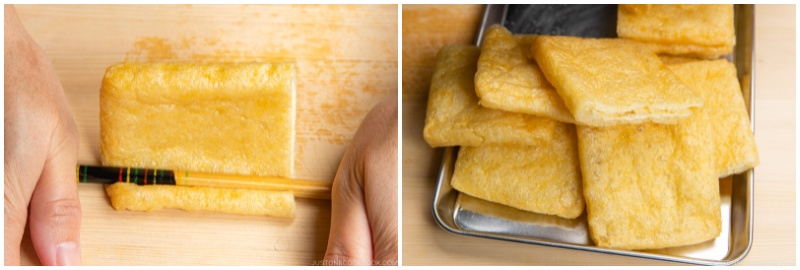
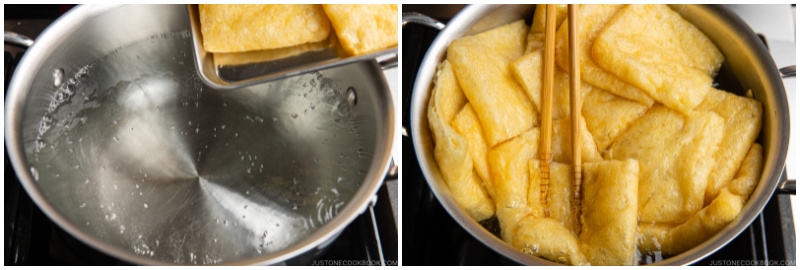
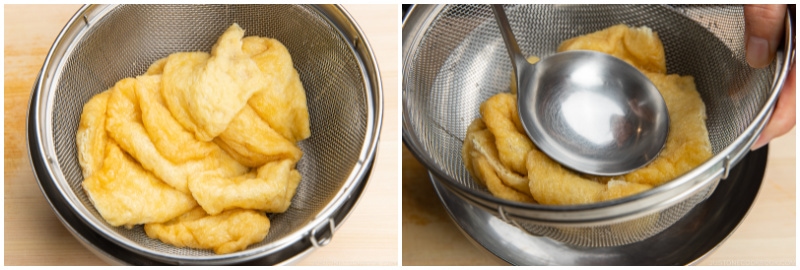
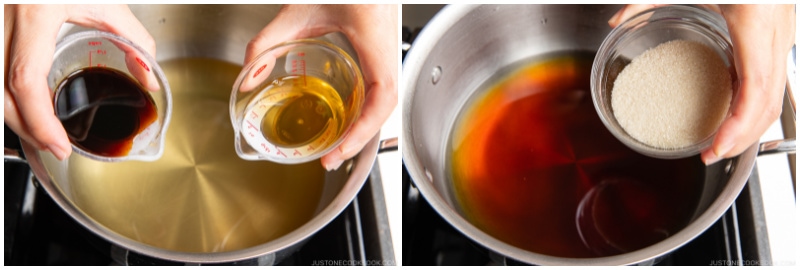
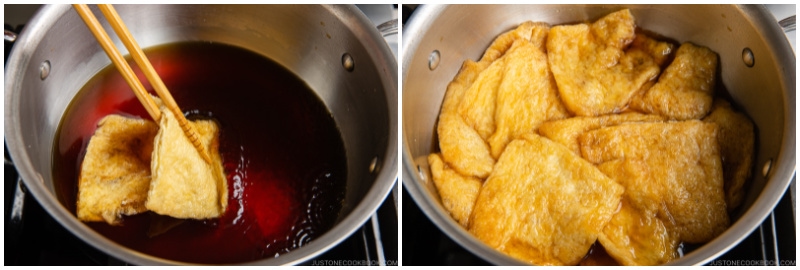
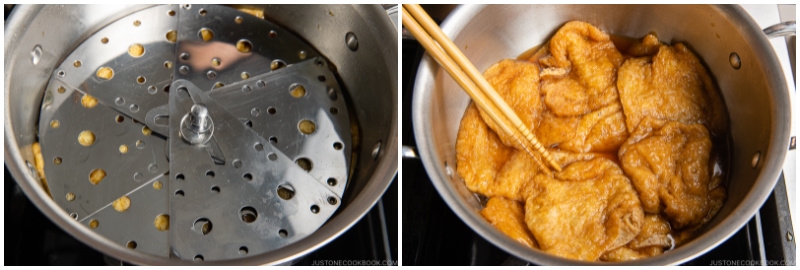
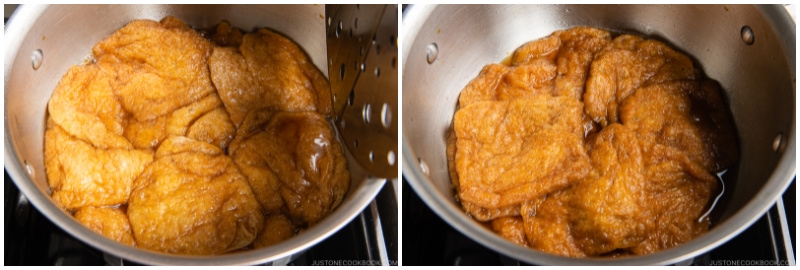
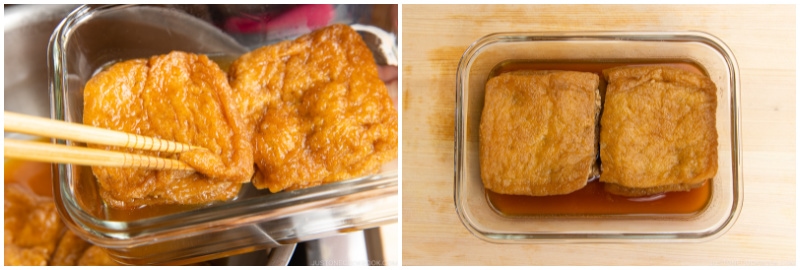










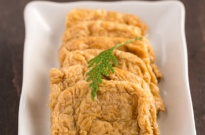
Whenever I buy store bought inari age, I’m always in a rush to finish it since it comes in such a huge portion so it would go bad on me if I don’t eat it in time. Now, I make my own with just the right amount and it’s preservative free, no syrupy sauce it comes in with and it’s not as sweet. Thank you, Nami. Problem solved.
Hi Wee. We are so happy to hear you enjoyed Nami’s homemade Inari Age.
Thank you so much for trying her recipe and for your feedback!
I never comment on recipes but I had to on this one. I made Inari sushi using your recipe and it was AMAZING. Tasted like (or better than) sushi at restaurants. I plan to keep aburage on hand from now on and make sure I save the bits of sushi rice left over from other cooking. Thank you!
Hi Audrey! Aww. Thank you so much for trying Nami’s recipe and for your kind feedback.
We are so happy to hear that you enjoyed the homemade Inari Age.
Happy Cooking!🤗
Never buy premade inari again! Keep the more versatile aburage in your freezer and then just simmer these when you want inari!
The smell of these simmering is amazing. The taste: just as divine.
Hello, John! Thank you for your words of encouragement!
Yes! The best Inari is homemade!🥰
I’m living in Tokyo and have made this recipe a couple times now. My little kids love this for our new favorite quick meal of kitsune udon! One question – if I am NOT planning to use the inari age for sushi, can I skip the step of opening up the pouches before I boil them? Thanks!
Hi Lizzie! Yes! You can skip the part.
Thank you for trying Nami’s recipes. We are so happy to hear your little ones love the Kitsune Udon with Homemade Inari Age! 😊
Hi Nami, thanks so much for the recipe! 🙂 If i am to freeze some Inari Age, how should I defrost them to be used for Inarizushi ? Please advise, thanks!
Hi Su, Thank you very much for reading Nami’s post and trying her recipe!
To defrost the frozen Inari Age, leaving it in the refrigerator for a few hours is the best.
We hope this helps!
Hi Nami,
the only thing I found were chinese aburaage cubes. I cut them in two, because I felt them to big for my taste and I thought when cooking them in water the inside soaks up a little oil too in abuurage pouches so I hope the taste is more similar. I will try to make some kind of inarisushi with them, even if I can’t fill them right, the taste should be alike.
Do you put the normal lid on top of the special one or is it desired that the water evaporates? I just used a plate that fits my pot. Now it’s simmering, I can’t wait to try the inari sushi rice thing tomorrow 😄 thank you as always fot your recipe!
Hi Anna! Thank you very much for reading Nami’s post and trying her recipe!
We hope you enjoyed the flavor of this dish!
Yes, you can put the smaller lid on top, and it will work! But Nami explains more about Otoshibuta in this post. https://www.justonecookbook.com/how-to-make-otoshi-buta/
We hope this is helpful.
Thank you.
I got another question: for how much gram are the nutrioninformation? For one portion? Most likely they are given for 100g. And is the sugar counted in
the carbohydrates or not? Thanks a lot in advantage. I lost 25kg with a calory counting App, and … I really like to keep it 😉
The Inari Sushi Rice was tasty, by the way. I only used too much of the Inari Age (I need to clean up my fridge), I think packed with rice it’s really delicious. With all my cubes the taste was overwhelming the rest a little bit too much
Hi Anna! We are glad to hear you enjoyed Inari Sushi rice! Thank you for trying Nami’s recipe.🙂
The nutrition information is per serving. The sugar in this recipe is counted in the Carbohydrates.
We hope this helps!
If using homemade aburaage, does one need still need to boil off the pouches in water before they go into soy mixture?
Hi Annette! Homemade aburaage sounds delicious!!!😃
Yes, we recommend following the recipe steps to remove extra oil so that Aburaage absorbs more seasoning.
We hope this helps!
Hey there!
Polish guy again XD
I have a question about aburaage… or rather how can you make those at home – I could not find them at any store (including Asia/Japan specializating)…
Well… I’ve found some recipes about making those at home, but still justonecookbook is definitly the best site with japanese recipes I’ve ever tried recipes from. So the big question for trusted master: Will recipe for homemade Aburaage show up on the site?
Hi Bauaser, We currently don’t have the recipe on the site, but here is the post link where Nami explains how to make it. https://www.justonecookbook.com/aburaage/ Please read “What is Aburaage?” We hope this helps!
They do sell canned prepared inari age, I have used it in a pinch and seen it on Amazon.
The first time I tried to make Inarizushi, I made the Inari age myself, based on JustOneCookBook. It turned out fine, but I am not adept at deep frying. I did use a candy thermometer, but it was hard to regulate the heat properly, and I have a gas stove. My homemade inari age were good enough, but I have since found the frozen ones at an Asian market in my city. Much easier to buy them frozen, and since they were recommended here, I felt I was still making these authentically!
おいしいですね! I can’t get enough and these are flavorful with the vegetarian dashi.
こんにちは、ハモンドさん! So glad to hear you enjoy this recipe! Thank you for your kind feedback!
This is a great recipe. Big hit with the fam. When I removed & cooled the aburaage then squeezed out the liquid I had roughly a cup leftover. Can I use this for my next batch to flavor the Aburaage for Inari sushi?
Hi Steve! Thank you for trying this recipe! I wouldn’t use this same marinade as it’s diluted (flavor is used for making this batch). You can use this sauce to sweeten other dishes. Like noodle soup, simmered dishes, etc.